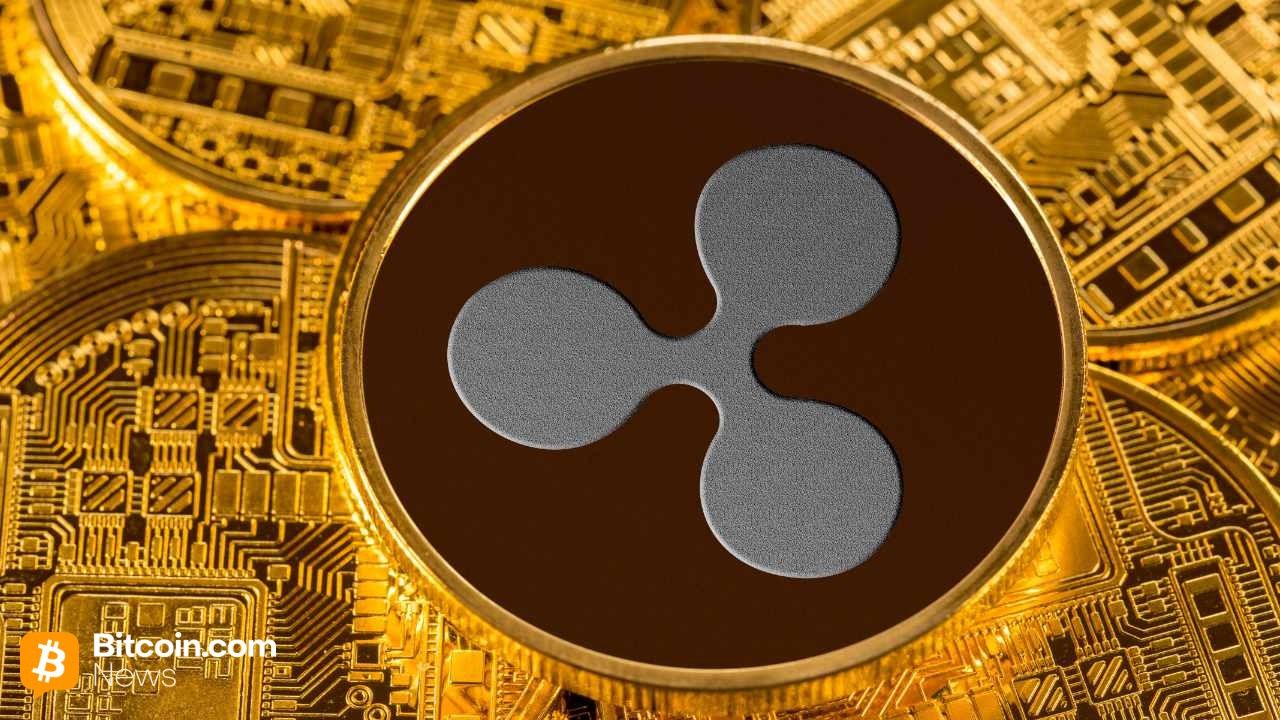
Category: Uncategorized
Sampson County man wins $130,000 jackpot days before 40th birthday – ABC11
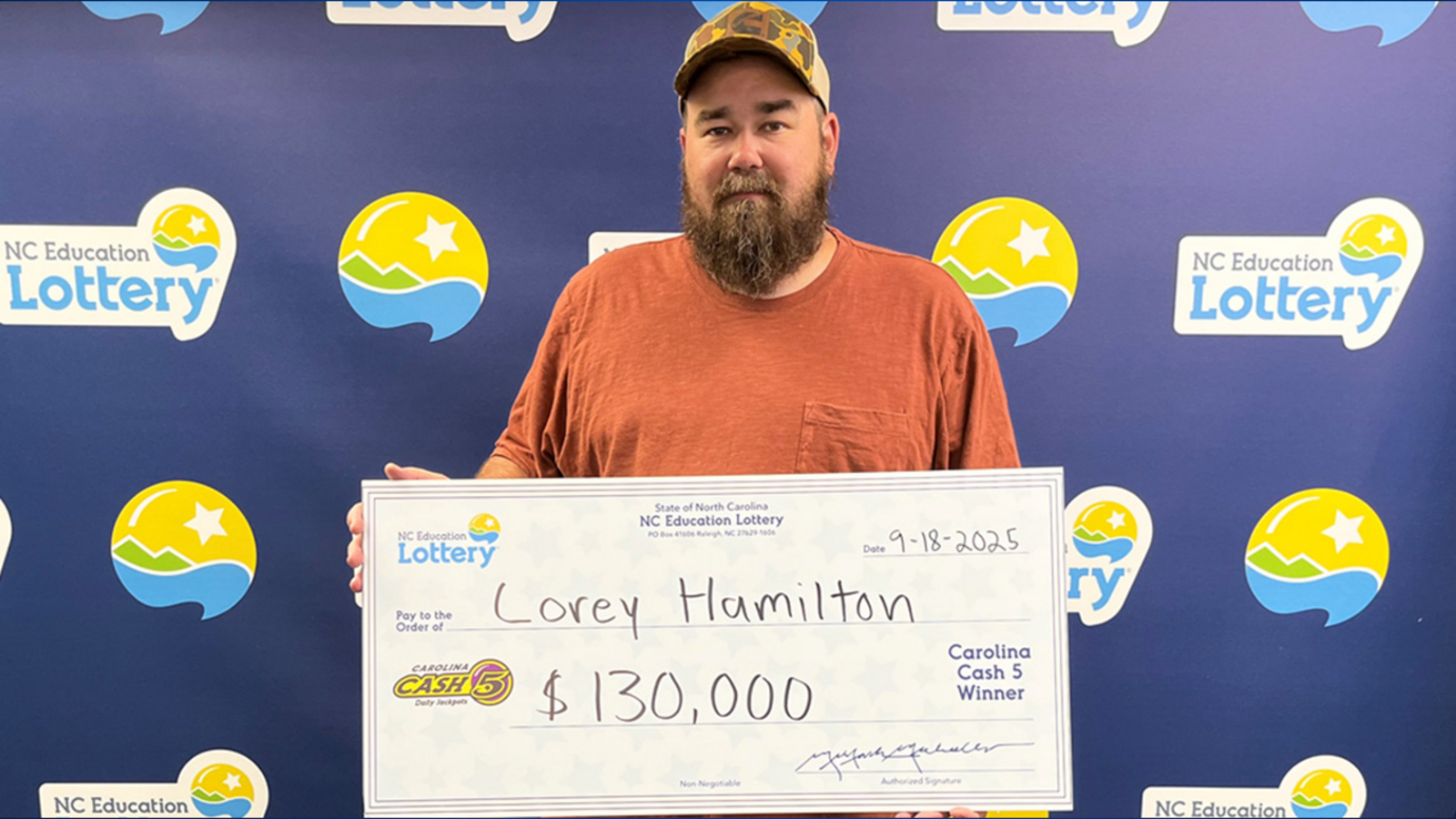
CLINTON, N.C. (WTVD) — A Sampson County man is celebrating after winning the $130,000 jackpot prize days before his 40th birthday.
"I don't even know how to describe the feeling," Corey Hamilton told the NC Education Lottery. "I just always felt that if it's meant to be, then it's meant to be."
Hamilton bought his winning $1 Cash 5 Quick Pick ticket from the Han-Dee Hugo's on Southeast Boulevard in Clinton. He said he found out he won when he checked his numbers early on Wednesday morning.
"I woke up at 3:30 and I was like, 'Wait a second, that can't be right,'" Hamilton said. "It has kind of all lined up since I turn 40 on Saturday."
After required federal and state tax withholdings, he took home $93,275, which Hamilton said he plans to use to buy a new truck, pay bills, and save for retirement.
Cash 5 is one of six lottery games in North Carolina where players have the option of buying tickets at a retail location, on the lottery's website, or on the app. Thursday's jackpot is $110,000.
ALSO SEE | Interest rate cuts could spur home, auto purchases
Pi Network (PI) Price: Trading Volume Surges 150% as PI Coin Breaks Key Resistance – CoinCentral

Pi coin recently completed a breakout above its horizontal channel resistance. This move came after the cryptocurrency climbed 2% with trading volume jumping nearly 150%.
The breakout occurred when PI closed above the upper boundary of its horizontal channel on Saturday. This channel had contained price movements between August 2 and August 8.
During yesterday’s session, the breakout generated 16% gains for PI holders. The move suggests renewed bullish sentiment among traders.
Today’s price action shows PI coin price maintaining momentum with a 2% increase. Trading volume reached $270 million by press time, representing a nearly 150% surge over 24 hours.
The combination of rising price and increased volume confirms trend strength. More participants are actively buying, which supports the current price movement.
PI’s price now trades above its 20-day exponential moving average at $0.4038. This technical indicator measures average price over the past 20 trading days, giving more weight to recent prices.
When an asset trades above its 20-day EMA, it typically indicates growing short-term bullish momentum. The EMA now provides dynamic support beneath the current price level.
The current price sits near $0.413, representing a 4% decline from recent highs. Pi encountered strong resistance at the $0.46 level, which coincides with a 4-hour supply block.
This resistance zone also aligns with the upper Bollinger Band, creating multiple layers of overhead pressure. The rejection occurred after a multi-day rally from the $0.326 low.
On the daily chart, PI remains within a broader downtrend. Descending trendline resistance continues to cap upside movement since May.
The recent rally broke above short-term dynamic levels but stalled at the confluence of the $0.46 supply zone. The daily EMA cluster also provided resistance at this level.
On-Balance Volume remains near multi-month lows despite the recent price spike. This suggests broader accumulation remains weak among institutional players.
The 4-hour chart shows price pushed above the 20 EMA at $0.391 and 50 EMA at $0.384. However, sellers successfully defended the 200 EMA at $0.4287.
If buying momentum continues, PI could target the key resistance level at $0.4451. A successful break above this barrier may push price toward $0.5281.
Conversely, profit-taking could send PI back to support near $0.3773. The mid-Bollinger Band at $0.4402 now acts as immediate resistance following the recent rejection.
Pi Network currently trades near $0.413 with volume remaining elevated at $270 million over the past 24 hours.
📈 Futures & Crypto Trader 🔍 Sharing charts, strategies, & mindset tips to help you level up 🚨 Not Financial Advice Follow on X @Pro_Trader_Edge
The cryptocurrency market confronts a persistent challenge that has defined trading strategies for years: how…

Never Miss Another Opportunity.
Get hand selected news & info from our Crypto Experts so you can make educated, informed decisions that directly affect your crypto profits!
Type above and press Enter to search. Press Esc to cancel.
BC Game Crypto: 100% Bonus & 400 Free Casino Spins, Claim Here!
Why Pi's Value Will Skyrocket : The Key Factors Revealed – investx.fr
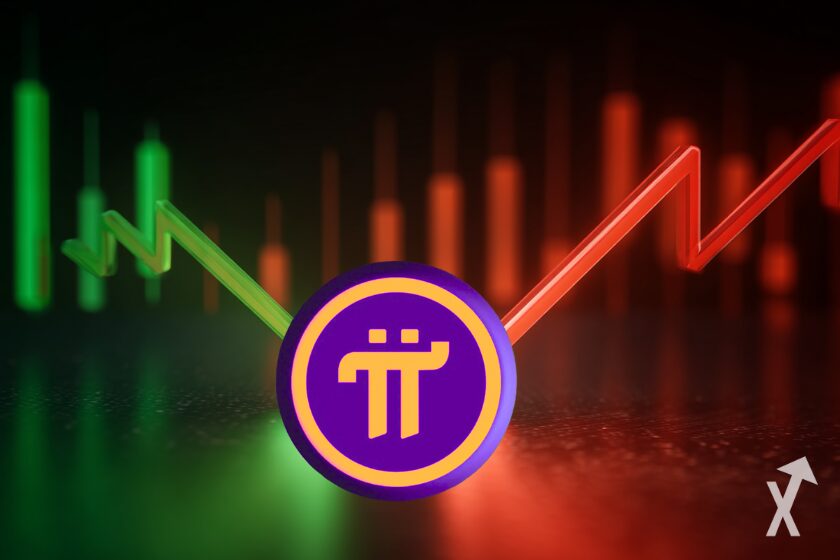
The Pi Network has faced challenges since the launch of its mainnet. Nonetheless, technical indicators point to a significant potential for a rebound in the coming days. Explore the catalysts that could drive the PI price to new highs.
Written by Simon Dumoulin
Translated on August 12, 2025 at 14:24 by Marie
Despite the price drop of Pi Network since its February launch, technical analysis reveals encouraging patterns suggesting substantial upside potential in the near future. On a 12-hour chart, the PI token has formed a double bottom at $0.40 with a neckline at $1.66, signaling a possible 154% rally from current levels.
Additionally, Pi Network has developed a large descending wedge pattern, often preceding a bullish breakout when both lines converge. Technical indicators also support this outlook, with the Relative Strength Index (RSI) climbing from 19.7 to 52 and a bullish crossover of the Percentage Price Oscillator (PPO) lines.
Several factors could support an upcoming surge in Pi Network’s price. First, the current crypto market rally, led by Bitcoin, could trigger a favorable season for altcoins like PI.
Furthermore, a listing on a major centralized exchange such as Binance, Coinbase, or Upbit could give the token fresh momentum, similar to other recently listed tokens. Finally, developer announcements regarding increased decentralization and additional token sales could also stimulate price growth.
In summary, technical signals and potential catalysts suggest a major trend reversal for Pi Network in the coming days. Savvy investors would be well-advised to closely monitor the evolution of this promising token.
Can Pi Network Reach a $1 Trillion Market Cap? Exploring the Possibilities Behind the $100 Pi Coin Vision#pinetwork #picoin #coin #crypto https://t.co/PbwIqqcQKc
To invest in the strategic asset that is Pi before a potential rebound, here’s a practical guide for obtaining it on Bitget :
More on this topic :
Passionate about cryptocurrencies since 2019, I cover the latest news through clear and accessible articles. My goal is to make crypto understandable for everyone, with reliable and well-researched content.
DISCLAIMER
This article is for informational purposes only and should not be considered as investment advice. Trading cryptocurrencies involves risks, and it is important not to invest more than you can afford to lose.
InvestX is not responsible for the quality of the products or services presented on this page and cannot be held liable, directly or indirectly, for any damage or loss caused by the use of any product or service featured in this article. Investments in crypto assets are inherently risky; readers should conduct their own research before taking any action and invest only within their financial means. This article does not constitute investment advice.
Risk Warning : Trading financial instruments and/or cryptocurrencies carries a high level of risk, including the possibility of losing all or part of your investment. It may not be suitable for all investors. Cryptocurrency prices are highly volatile and can be influenced by external factors such as financial, regulatory, or political events. Margin trading increases financial risks.
CFDs (Contracts for Difference) are complex instruments with a high risk of rapid capital loss due to leverage. Between 74% and 89% of retail investor accounts lose money when trading CFDs. You should assess whether you understand how CFDs work and whether you can afford to take the high risk of losing your money.
Before engaging in financial or cryptocurrency trading, you must be fully informed about the associated risks and fees, carefully evaluate your investment objectives, level of experience, and risk tolerance, and seek professional advice if needed. InvestX.fr and the InvestX application may provide general market commentary, which does not constitute investment advice and should not be interpreted as such. Please consult an independent financial advisor for any investment-related questions. InvestX.fr disclaims any liability for errors, misinvestments, inaccuracies, or omissions and does not guarantee the accuracy or completeness of the information, texts, graphics, links, or other materials provided.
Some of the partners featured on this site may not be regulated in your country. It is your responsibility to verify the compliance of these services with local regulations before using them.
© InvestX 2025
Two lucky Arkansans win big on the same day – thv11.com

LITTLE ROCK, Ark. — Two lucky Arkansans won big from their instant lottery tickets and claimed their prize on the same day.
According to the Arkansas Scholarship Lottery (ASL), Amanda H. from Baxter County won $100,000 playing $100,000 Golden Ticket, a $5 instant game, and James Guerin from Saline County won $50,000 playing $50,000 Frenzy.
Amanda told ASL that she only plays occasionally whenever she has some extra cash. When she does, she selects her tickets by intuition.
“I just have this gut feeling,” she told lottery officials.
Her instincts would lead her to the last $100,000 Golden Ticket in the retailer’s lottery bin.
She was then stunned when she scratched off the winning ticket at home and discovered that she had won a $100,000 top prize.
“Next thing you know, it’s like— ‘No way!’” she said. “I never imagined I would win anything like this,” she said. “If you have that gut feeling, go with it!”
ASL stated that Amanda plans to build a home on some land with her winnings and intends to continue playing lottery games.
Guerin was traveling when he stopped in Cabot and bought the $20 ticket for his favorite game with a $1 million top prize that was sold out.
He scratched it in the store initially, assuming he won a smaller prize. He then realized that he had actually won a $50,000 top prize instead; all he could think was “Wow!”
Guerin has no plans for his win yet, but told ASL he has considered putting it in the bank, and he also plans on continuing to play lottery games for bigger prizes.
To stream THV11 on your phone, you need the THV11 app.
Next up in 5
Example video title will go here for this video
Next up in 5
Example video title will go here for this video
In Other News
The next $1 token? Why Ozak AI is tipped to explode – Latest news from Azerbaijan
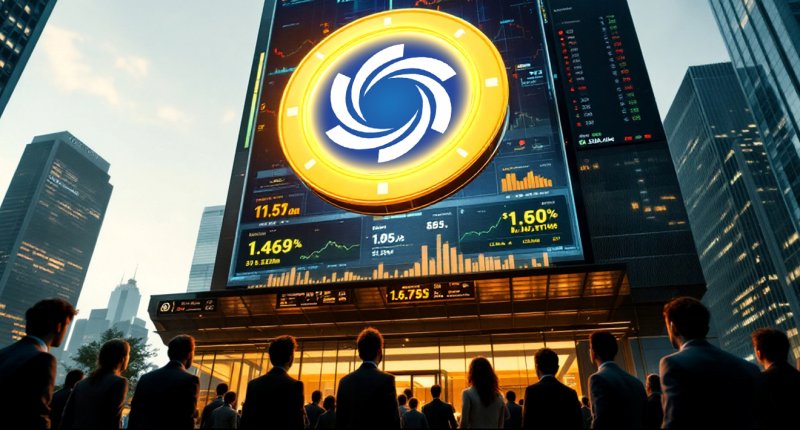
Ozak AI has emerged as one of the most promising projects in the market. The $OZ token presale offers an unprecedented blend of decentralized artificial intelligence, blockchain, and predictive technologies that are grabbing the interest of experienced traders as well as first-time investors.
Ozak AI is currently trading at $0.005 per token, granting early investors an attractive option of joining in a project that has the potential of generating high returns.
Ozak AI’s $OZ token presale: A glimpse of future gains
The $OZ token presale has gained significant momentum after Phase 4 of the presale raised 134.8 billion tokens and generated more than 1.87 million. In the next stage, the presale price will rise to $0.01 per token.
This trend suggests that great potential currently exists among early investors since there is a probability that the value of the token can explode exponentially once it reaches the target value of $1.00.
This 200x upside to the current presale price says a lot about the possibilities of future growth. It is noteworthy, though, that the presale is still not finished and that even as the progress bar is about to hit complete, there are a very small number of tokens left at the current price. This gives the remaining presale opportunity a desirable engagement to the interested parties that would like to get in as early as possible.
Youtube embed:
Next 500X AI Altcoin
Ozak AI platform: Revolutionizing decentralized AI
What makes Ozak AI stand out in the crowded crypto market is its platform’s unique integration of artificial intelligence (AI) and blockchain. Ozak AI operates by using a machine learning algorithm as it analyzes large volumes of data to provide the user with actionable insights. This means that the blockchain technology that interacts with the platform provides secure and tamper-proof data processing due to decentralized storage and smart contracts.
The main component of Ozak AI is its Ozak Stream Network (OSN), which is a totally decentralized system aimed at managing high-frequency AI predictions. The scalability of the platform, where new nodes are added using the platform, is one of the characteristics of the platform that makes it very flexible for real-time and complicated financial requirements.
Besides the predictable AI, Ozak AI has the capability to guarantee effective and convenient access to data through the utilization of Decentralized Physical Infrastructure Networks (DePIN). The project that integrates the usage of AI-based decision-making and the blockchain technology infrastructure makes it a leader in the AI and decentralized finance (DeFi) market.
Strategic partnerships and growing ecosystem
Ozak AI’s growth is further supported by a series of strategic partnerships with key industry players. Partnerships with blockchain development companies, artificial intelligence research teams, and DeFi systems are furthering the technological potential of the project, diversifying it, and opening it up to a wider range of users worldwide.
The latter sets up Ozak AI partnerships, such as one with Sint Labs, to introduce sophisticated AI analytics into actual blockchain business practices, a move that enhances the firm’s long-term value pitch. Such alliances not only offer a competitive advantage to the project but also give access to new distribution channels to the platform, and it means that Ozak AI might become mass-market-friendly.
The path to $1: A strong growth trajectory
The presale performance and strategic partnership opportunities give Ozak AI a good chance to achieve its launch price target of $1. If the project continues its trajectory, investors who purchase $OZ tokens at the current presale price of $0.005 could see a 200x return once the token hits $1 at launch.
The idea behind pointing out a combination of AI-based prediction agents and blockchain scalability, with an ability to create new partnerships, has made Ozak AI one of the major blockchain projects to look out for in 2025. High returns, along with its practical applications, make the project a unique opportunity that investors should look forward to when aiming to make a profit out of the next big experience in the crypto market.
Final thoughts
The presale of Ozak AI with the $OZ token proves to be an exclusive chance to invest in a potentially large-scale, rewarding project. With its advanced AI technology, blockchain infrastructure, and the growing network of various partnerships, Ozak AI has high potential for more gains.
For more information about Ozak AI, visit the links below:
Website: https://ozak.ai/
Twitter/X: https://x.com/OzakAGI
Telegram: https://t.me/OzakAGI
News.Az
News.Az is an Azerbaijani informational-analytical news portal that publishes a wide range of content, including analytical materials, in-depth articles, insightful commentaries, and the latest news.
© 2009-2025 NEWS.AZ | Any use of materials is allowed only if there is a hyperlink to News.Az. All rights are reserved.
London Stock Exchange lists new Bitcoin staking ETP – Cointelegraph
Winning Set For Life numbers for Thursday September 18 £10k a month jackpot – The Sun

THE National Lottery Set For Life numbers are in and it's time to find out if you've won the top prize of £10,000 every month for 30 years.
Could tonight's jackpot see you start ticking off that bucket list every month or building your own start-up as a budding entrepreneur?
You can find out by checking your ticket against tonight's numbers below.
Good luck!
The winning Set For Life numbers are: 18, 19, 22, 34, 40 and the Life Ball is 05.
The first National Lottery draw was held on November 19 1994 when seven winners shared a jackpot of £5,874,778.
The largest amount ever to be won by a single ticket holder was £42million, won in 1996.
Gareth Bull, a 49-year-old builder, won £41million in November, 2020 and ended up knocking down his bungalow to make way for a luxury manor house with a pool.
Sue Davies, 64, bought a lottery ticket to celebrate ending five months of shielding during the pandemic — and won £500,000.
Sandra Devine, 36, accidentally won £300k – she intended to buy her usual £100 National Lottery Scratchcard, but came home with a much bigger prize.
The biggest jackpot ever to be up for grabs was £66million in January last year, which was won by two lucky ticket holders.
Another winner, Karl managed to bag £11million aged just 23 in 1996.
The odds of winning the lottery are estimated to be about one in 14million – BUT you've got to be in it to win it.
©News Group Newspapers Limited in England No. 679215 Registered office: 1 London Bridge Street, London, SE1 9GF. “The Sun”, “Sun”, “Sun Online” are registered trademarks or trade names of News Group Newspapers Limited. This service is provided on News Group Newspapers’ Limited’s Standard Terms and Conditions in accordance with our Privacy & Cookie Policy. To inquire about a licence to reproduce material, visit our Syndication site. View our online Press Pack. For other inquiries, Contact Us. To see all content on The Sun, please use the Site Map. The Sun website is regulated by the Independent Press Standards Organisation (IPSO)
Our journalists strive for accuracy but on occasion we make mistakes. For further details of our complaints policy and to make a complaint please click this link: thesun.co.uk/editorial-complaints/
CDC's vaccine advisory panel, with new members picked by RFK Jr., votes on measles shot – CBS News
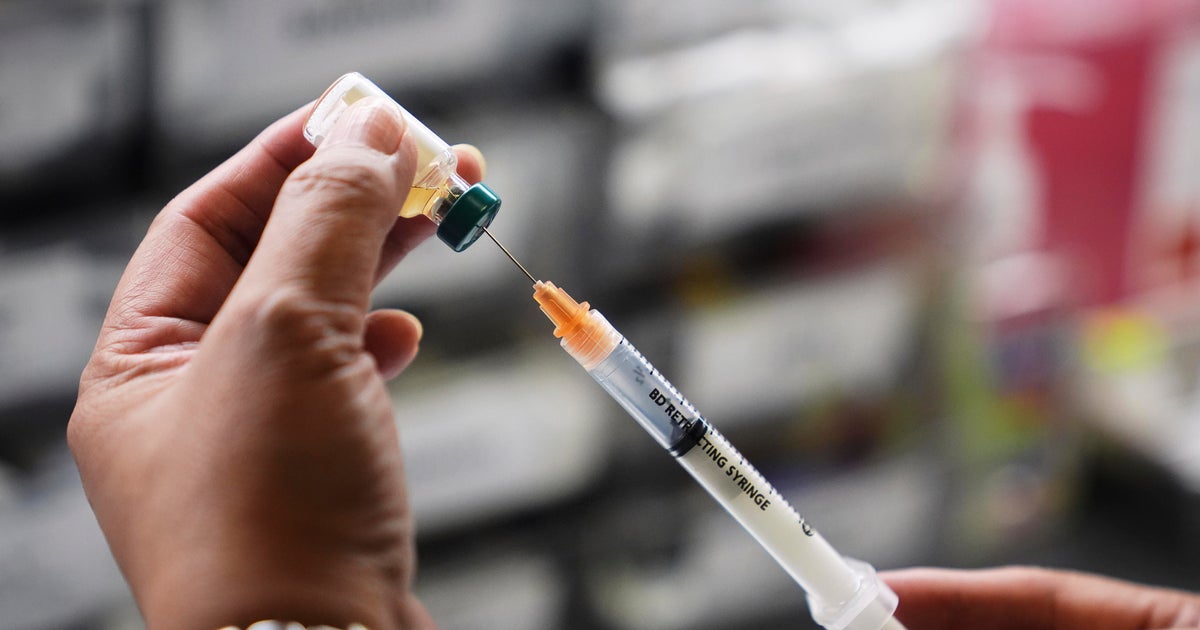
Watch CBS News
/ CBS News
After much confusion among the members over the vote on vaccine coverage under the Vaccines for Children program, which helps certain groups pay for immunizations, the majority voted no, meaning coverage will stay as is in covering both the combined MMRV and two separate MMR+V vaccines for those under age 4 — even though the committee had previously voted against recommending the combined MMRV shot for this group.
“VFC and CMS [Centers for Medicare & Medicaid Services] wouldn’t be doing the same thing here, because CMS is going to be tied to the recommendation. VFC is tied to the resolution. So it is possible to have two different things, but there is a potential area for confusion when it’s covered differently under one program than others,” Vaccines for Children spokesperson Dr. Jeanne Santoli said.
The final vote included one yes, 8 no and 3 abstentions — some due to confusion over what the vote was about.
“Sorry to prolong it. I’m going to abstain because I’m not quite sure what I’m voting for,” Meissner said.
As explained by Santoli, the VFC program supports groups including those on Medicaid, uninsured or underinsured children, as well as American Indian and Alaska Native populations.
In a vote of 7 to 3, with one abstention, the ACIP committee voted to change the recommendation to the following: “For measles, mumps, rubella and varicella vaccines given before age 4 years, the combined MMRV vaccine is not recommended.”
Instead, the group recommends children in this age group receive a separate measles-mumps-rubella vaccine and varicella vaccine, or MMR+V.
For parents, the combined MMRV vaccine offers the convenience of one shot instead of two, but it does carry a slightly higher risk of fever-related “febrile” seizures when used as the first dose in young toddlers aged 12-23 months. The side effect is most common between ages 14-18 months. As CBS News medical contributor Dr. Céline Gounder explains, febrile seizures are rare and almost always resolve without lasting effects, but are frightening for families and can erode trust in vaccines.
By contrast, studies show there is no elevated risk when MMRV is given for the second dose at ages 4 to 6 years old, after children have outgrown the highest-risk window.
Before moving on to public comments, Kulldorff said there is a “slight discrepancy in these two votes,” adding that the committee will plan to vote on the hepatitis B vaccine recommendation tomorrow instead of today.
The committee is also scheduled to vote on COVID-19 vaccine recommendations tomorrow.
On the topic of hepatitis B, there will be votes on two different recommendation changes.
The language for the first proposed change was presented as: “All pregnant women should be tested for hepatitis B infection.”
The second proposed change was presented as follows:
“The pediatric vaccine schedule should be updated to reflect the following change:
*Also referred to as shared clinical decision-making.”
In response to the questions brought up by the liaison members, ACIP member and RFK Jr. ally Dr. Robert W. Malone said that, to him, the question sounded “a little disingenuous or at least self-evident.”
“It’s clear that a significant population of the United States has significant concerns about vaccine policy and about vaccine mandates,” he said. “There has been a significant decrease in public support for vaccination and a significant increase in concerns about public health and the ability of the population to rely on public health — and the hepatitis B birth dose has been a focus of folks that have these types of concerns.”
Malone said he had no direct communication with CDC leadership or HHS leadership about why this was a priority for this week’s meeting.
“I’m just inferring based on what I understand about public opinion,” he said.
Middleman and other organization representatives, including Dr. Flor M. Muñoz with the National Foundation for Infectious Diseases, asked the committee why this proposed change to hepatitis B was even brought up for discussion for a vaccine that has a long-standing recommendation and history of safety.
“Why are we addressing this hepatitis B vaccine recommendation? Is there really a reason that the committee can provide for making a change?” Muñoz asked.
“I’m wondering what problem exists in the current schedule that has prompted this entire discussion?” Middleman previously asked.
Kulldorff announced a 10-minute break, leaving the questions unanswered.
After not being called on during a previous discussion period, Dr. Amy Middleman, a liaison for the Society for Adolescent Health and Medicine, brought up the importance of top medical organizations such as herself and others on the call who have recently been excluded from the ACIP’s working groups.
“How can we make sure that we add the liaison members back into the working group so that they can contribute, on behalf of their patients and their knowledge base?” she asked.
ACIP chair Kulldorff blamed the removal of the organization members from the working groups on a FACA, or Federal Advisory Committee Act, requirement.
“This is a policy across all of CDC that is sort of outside the control of this committee,” he said. “In the past, ACIP did not meet this FACA requirement, which is a formal legal requirement.”
He agreed, to Middleman’s point, that input from others is “enormously valuable,” adding that the committee does have “many outside experts that we call in.”
After all presentations on the potential risks of hepatitis B vaccination, some members of the ACIP clashed on what the data meant for the vote they would be taking later today.
Member Vicky Pebsworth, a regional director of the National Association of Catholic Nurses, said “there are gaps in what we know and understand about the effects of hepatitis B, particularly on very young infants, and I think that the conclusion that it is safe is perhaps premature.”
Dr. Cody Meissner, a pediatrics professor who previously served as a member of the Food and Drug Administration’s vaccines panel, however, called the vaccine “safe” with “no evidence of harm.”
If the recommendation changes, he added, it would “increase the risk of harm based on no evidence of benefit, because there will be fewer children who will get the full hepatitis B vaccine series.”
In the first presentation for the hepatitis B vaccine, presenter Dr. Adam Langer with the CDC outlined how changing the current recommendation for a first dose within 24 hours of birth could put more children at risk, even those born to mothers who test negative for the disease.
Langer gave examples of situations where unvaccinated infants are at risk of HBV infection, including:
“About half of people with HBV infection are unaware of their infection so they could unknowingly expose infants that are in their care,” he said.
Additionally, he said there is “no evidence that the risk of already rare adverse events is any greater among newborns than among older infants.”
The only potential benefit to rescinding the current recommendation is a potential reduction in rare cases of adverse effects from the birth dose vaccine, according to the presentation.
“When they do occur, these adverse events tend to be mild. The worst adverse event you could imagine, anaphylaxis has been very rarely reported at only 1.1 cases per 1 million vaccine doses administered,” Langer said.
After the lunch break, presentations and discussions shifted to the hepatitis B vaccine.
ACIP chair Martin Kulldorff reminded the group that the proposed recommendation changes concern only the hep B birth dose — the dose given to babies within 24 hours of birth — to mothers who test negative for the disease.
“So if the women test positive for hepatitis B, or if it’s unknown, we are not considering any changes for that population,” he said.
Just before the group paused for lunch, ACIP member Dr. Joseph Hibbeln brought up the impact the proposed recommendation change for MMRV vaccines would have on parents who want the single, combined measles, mumps, rubella and varicella shot for their children, since they would no longer be covered by the Vaccines for Children program which helps pay for immunizations.
“So that implies that the parents’ choice, unless they want to pay for it themselves, the parents’ choice is taken away,” he said, adding even if parents wanted the single shot, understood the benefits and risk, or even had a hard time accessing clinical care, “that option is basically taken away from them.”
Andrew Johnson, a representative with the Centers for Medicare & Medicaid Services, added that the change would also have coverage implications in the Medicaid and Children’s Health Insurance Program as well as individual and group markets.
Dr. Jason Goldman, president of the American College of Physicians, shared his concerns about the MMRV presentation at the meeting following a recent change in the ACIP process that removed top medical organizations from the committee’s working groups.
“You do not have those subject matter experts with the real-world experience to understand the implementation of these vaccines and the concerns of the patients,” Goldman said. “You don’t have the voice of the patients we take care for. You’re not looking at all of the aspects of how we evaluate vaccine implementation. You’re looking at very small data points and misrepresenting how it works in the real world and how we take care of our patients. So no, this was not a thoroughly vetted discussion”
Other medical organization leaders chimed in to echo his concern and message.
The proposed recommendation language, which will later go to a vote, was presented as follows:
“The pediatric vaccine schedule should be updated to reflect the following change:
Currently, the CDC says the MMRV vaccine may be used in that age range if preferred by parents or caregivers to reduce the number of shots.
After presentations on the background and potential risks of febrile seizures with an MMRV vaccine — which combines the MMR and varicella shots — versus separate MMR and varicella shots, members discussed whether guidance should be changed.
Some members were satisfied with the current recommendations, which make clear the slightly higher risks of febrile seizures with the combined shot.
“I think the current wording is appropriate,” Dr. Cody Meissner, a pediatrics professor who previously served as a member of the Food and Drug Administration’s vaccines panel, said.
Others were not assured, saying there were too many assumptions being made. Some also pointed out that even if there are no worries about the physical impact of febrile seizures, the mental impact the event can have on children and families could affect vaccine compliance.
Dr. Richard Haupt, the head of global medical and scientific affairs, vaccines and infectious diseases at Merck, the vaccine’s manufacturer, noted the recent decline in vaccination rates among kindergarten children and highlighted the need to make guidance clear for the public.
“Considering these trends, any policy decision that compromises the clarity or consistency of vaccination guidance has the potential to further diminish public confidence,” he said.
During Thursday’s meeting, ACIP chair and biostatistician Martin Kulldorff noted the removal of CDC Director Dr. Susan Monarez and other members of CDC leadership, including former chief medical officer Dr. Debra Houry — both of whom testified a day prior about their removal.
“On vaccines, this committee is the key adviser to the CDC director, but during her short tenure, she never contacted me as the ACIP chair about any of her questions or concerns, which would have been natural if she had such concerns, neither was I contacted by any of the three CDC leaders, who subsequently resigned,” he said.
Kulldorff said the CDC leadership left citing divergent opinions about vaccines, but Monarez said she was also pressured by Kennedy to fire career experts without cause and approve vaccine recommendations without scientific evidence.
Kulldorff also said the American Academy of Pediatrics ended its participation with the committee and ignored invitations for open discussion about vaccines.
Last month, for the first time in 30 years, the AAP shared guidance that differed from the U.S. government. The organization said it is “strongly recommending” COVID-19 shots for children ages 6 months to 2 years old. Under Kennedy, the CDC doesn’t recommend COVID-19 shots for healthy children of any age. Instead, it says parents may get their kids vaccinated in consultation with physicians.
As the meeting kicked off Thursday with a roll call, ACIP members presented some of their career backgrounds — and some took the time to highlight their views on vaccines.
Dr. Evelyn Griffin, an obstetrician and gynecologist based in Louisiana who was added to the panel earlier this week, said she would call herself “pro-informed consent.”
“Because of medical ethics, for discussing risk benefits and alternatives with the patient,” she said. “During the pandemic, I myself was COVID vaccinated.”
An earlier Kennedy pick, Dr. Joseph Hibbeln, who is retired from the National Institutes of Health, said he has a “neutral mind towards vaccines” and is “approaching this with a scientific equity.”
Dr. James Pagano, described by Kennedy as a “strong advocate for evidence-based medicine,” disclosed that he’s been vaccinated numerous times against various diseases.
“So I’m not anti-vax,” he said. “I am pro-intelligent and informed utilization of these potentially life-saving medications in a manner that reflects the current state of the art regarding their benefits, the target populations, optimal dosing and timing and, yes, of their potential adverse effects in some people.”
The ACIP is convening under an unaccustomed spotlight. The committee usually attracts little attention as it deliberates vaccine schedules and eligibility, but suddenly finds itself navigating political scrutiny, public skepticism and internal upheaval.
The stakes extend well beyond the technical details of dosing intervals or eligibility cutoffs. The panel’s decisions could reshape public trust in childhood vaccines, restrict access to vaccines through Medicaid and Medicare, and signal whether scientific consensus or political pressure will steer the nation’s vaccination strategy.
Read more here.
For hepatitis B, the CDC currently recommends the first dose within 24 hours after birth. Universal infant vaccination became the norm in 1991 after data showed too many cases of hepatitis B among pregnant women were missed during prenatal care.
A universal birth dose acts as a safety net, protecting infants whose parent’s infection might have been missed. Before birth-dose policies, the U.S. saw an estimated 1,000 preventable infections in newborns each year.
To protect against measles, mumps, rubella and varicella (or chickenpox), there are two options: a combo MMRV vaccine or separate MMR and varicella vaccines.
The CDC currently recommends a two-dose series beginning at age 12 to 15 months. However, the combination vaccine contains certain risks for younger age groups; specifically, the combo shot carries a slightly higher risk of fever-related “febrile” seizures when used as the first dose in young toddlers aged 12-23 months.
“For dose 1 in children age 12–47 months, it is recommended to administer MMR and varicella vaccines separately,” the CDC says, but adds MMRV may be used if preferred.
While testifying at a Senate hearing Wednesday about why she was ousted as CDC director, Dr. Susan Monarez said she’s “very nervous” about the newly appointed ACIP members and what their recommendations might be.
“I know that the medical community has raised concerns about whether or not, again, they have the commensurate backgrounds to be able to understand the data, the evidence, and to evaluate it appropriately, but I certainly will be watching,” she said.
In another part of the hearing, Monarez said she refused to rubber-stamp vaccine recommendations without seeing the evidence behind them because she “built a career on scientific integrity.”
“My worst fear was that I would then be in a position of approving something that would reduce access to lifesaving vaccines to children and others who need them,” she said.
Monarez added she is not aware of any scientific evidence to support changing the childhood vaccination schedule for measles, chicken pox and hepatitis B.
After firing all 17 of the committee’s previous members in June, Kennedy named eight new advisers to the ACIP, one of whom later withdrew. They include several allies he has worked with closely over the years and some have a history as vaccine critics.
Kennedy appointed the new members directly, breaking with the past practice of agency officials vetting potential experts before sending them to the secretary for approval.
Just this week, the group gained five new members, the HHS announced. The latest additions include some who have questioned established medical research on immunizations and the COVID-19 pandemic.
A day before the ACIP meetings kicked off, a group of four West Coast states recommended that all adults and children in those states who want them can receive the COVID-19 vaccine and other common shots.
The announcement was made in a joint statement from Oregon Gov. Tina Kotek, Washington Gov. Bob Ferguson, California Gov. Gavin Newsom and Hawaii Gov. Josh Green, all Democrats, saying they were putting safety before politics.
The guidance, which aligns with mainstream medical groups like the American Academy of Family Physicians and American Academy of Pediatrics, comes amid confusion over the CDC’s messaging on vaccinations.
Sara Moniuszko is a health and lifestyle reporter at CBSNews.com. Previously, she wrote for USA Today, where she was selected to help launch the newspaper’s wellness vertical. She now covers breaking and trending news for CBS News’ HealthWatch.
Copyright ©2025 CBS Interactive Inc. All rights reserved.
Epic Universe visitor dies after riding roller coaster at Florida park – NBC News
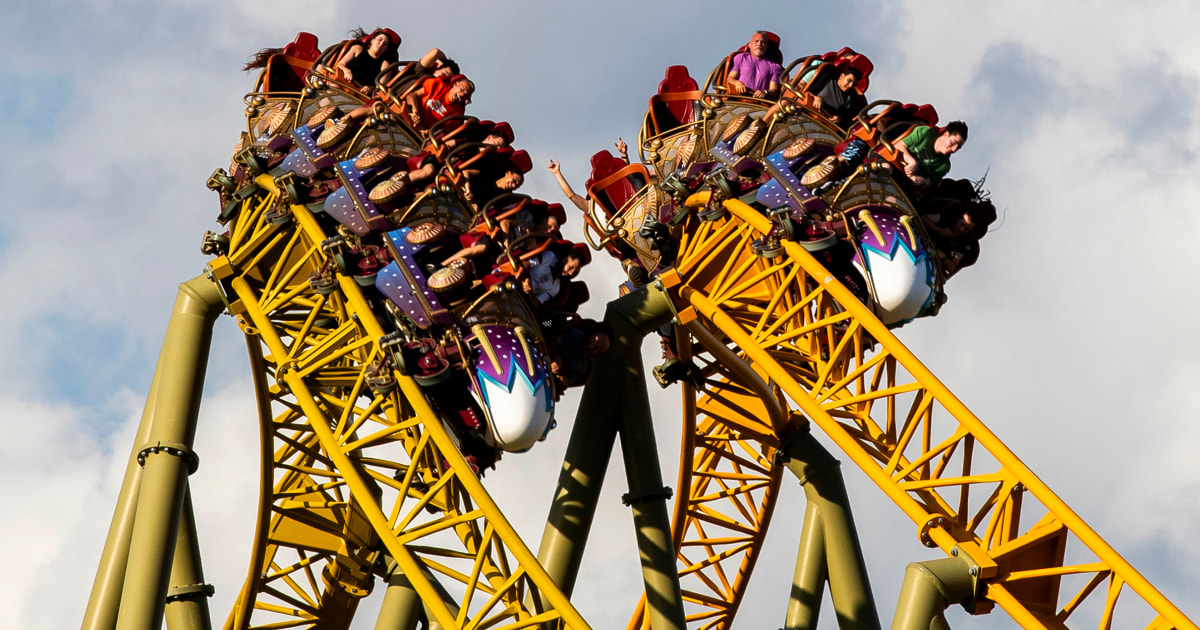
Profile
Sections
Local
tv
Featured
More From NBC
Follow NBC News
news Alerts
There are no new alerts at this time
A guest at Universal’s Epic Universe in Orlando died Wednesday after riding a roller coaster at the new theme park, park officials said in a statement.
The person became unresponsive while riding Stardust Racers at the Florida park, a Universal spokesperson said in the statement.
The attraction remains closed, according to the statement.
The Orange County Sheriff’s Office said off-duty deputies found a man in his 30s on the ride. He was then taken to the hospital, where he was pronounced dead.
It is not clear how he died. The District Nine Medical Examiner’s Office said the person’s body was in their care and will undergo an examination today.
The Universal spokesperson said the park is cooperating with the Sheriff’s Office’s investigation. Representatives from NBCUniversal did not immediately respond to NBC News’ request for comment.
“We are devastated by this tragic event and extend our sincerest sympathies to the guest’s loved ones,” the Universal spokesperson said.
Epic Universe opened in May and features a slew of new attractions, including Nintendo World and The Wizarding World of Harry Potter’s Ministry of Magic.
Epic Universe and NBC News share the same parent company, NBCUniversal.
Rebecca Cohen is a breaking news reporter for NBC News Digital.
Assignment Editor, NBC News
Assignment editor
© 2025 NBCUniversal Media, LLC

